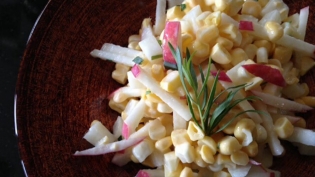Getting the Most Out of Your Produce
Most of us, when we shop or pick up our community-supported agriculture (CSA) boxes, tend to throw our fruit and veggies into plastic bags and dump them in the refrigerator crisper, where they sit neglected for days. By the time we get to them, they’re often past their prime, wilted, or even starting to rot.
Making the most of your fresh produce, whether they come from a CSA box, the farmers market, a grocery store, or your backyard garden, means properly selecting and storing them. Too often, our precious produce rots or spoils because we didn’t choose the best specimens in the first place and then improperly stored them. And just because you store one veggie a certain way doesn’t mean it’s suitable for another one—different crops have surprisingly specific needs.
Then we sigh, throw them away, and declare it’s too hard to eat more healthfully.
It doesn’t have to be this way. With proper selection, storage, trimming, and cleaning, you can enjoy a lot more of what you bring home—and maximize your food dollars.
Here are some basic storage tips:
 When you get your fruit and veggies home, make it a habit to prep them right away.
When you get your fruit and veggies home, make it a habit to prep them right away.
 The longer you let your produce sit around, the more likely you are to forget about it and that it will go to waste.
The longer you let your produce sit around, the more likely you are to forget about it and that it will go to waste.
 Don’t wash greens, mushrooms and most vegetables until you’re ready to use them.
Don’t wash greens, mushrooms and most vegetables until you’re ready to use them.
 Leaf and romaine lettuce are exceptions—wash and dry them thoroughly right away. Wrap in a dry kitchen towel before storing.
Leaf and romaine lettuce are exceptions—wash and dry them thoroughly right away. Wrap in a dry kitchen towel before storing.
 Plastic bags trap moisture and gases, causing produce to spoil faster; slip in a couple of slightly damp or dry paper towels. Better yet, use breathable reusable cotton or mesh storage bags.
Plastic bags trap moisture and gases, causing produce to spoil faster; slip in a couple of slightly damp or dry paper towels. Better yet, use breathable reusable cotton or mesh storage bags.
 If your greens, cucumbers or green beans are wilted, submerge them in ice water for 30 minutes to an hour to revive them.
If your greens, cucumbers or green beans are wilted, submerge them in ice water for 30 minutes to an hour to revive them.
 Treat all fresh herbs like cut flowers—simply snip off the stem ends, place them in water, and store them on the counter at room temperature or in the refrigerator.
Treat all fresh herbs like cut flowers—simply snip off the stem ends, place them in water, and store them on the counter at room temperature or in the refrigerator.
 Keep potatoes, winter squashes, garlic, and cured onions in a cool, dry, dark, well-ventilated place. But don’t store potatoes and onions in the same place—they’ll spoil faster!
Keep potatoes, winter squashes, garlic, and cured onions in a cool, dry, dark, well-ventilated place. But don’t store potatoes and onions in the same place—they’ll spoil faster!
 Regularly examine your produce for any soft spots, yellowing leaves, slimy bits, or mold—they spread quickly. Cut out the affected areas and use the produce right away.
Regularly examine your produce for any soft spots, yellowing leaves, slimy bits, or mold—they spread quickly. Cut out the affected areas and use the produce right away.
 Don’t store tomatoes or unripened peaches in the refrigerator— it ruins their flavor and makes them mealy.
Don’t store tomatoes or unripened peaches in the refrigerator— it ruins their flavor and makes them mealy.
 Avocados, apples, pears, bananas, and onions all produce ethylene gas, which make potatoes and greens spoil faster.
Avocados, apples, pears, bananas, and onions all produce ethylene gas, which make potatoes and greens spoil faster.
 Keep plums, pluots, apricots, peaches, and nectarines at room temperature until they’re fully ripe. Then refrigerate them. But cherries spoil quickly—refrigerate them right away.
Keep plums, pluots, apricots, peaches, and nectarines at room temperature until they’re fully ripe. Then refrigerate them. But cherries spoil quickly—refrigerate them right away.
 Carrots, celery, radishes, and other veggies can be washed, peeled, and cut ahead of time so they are ready for snacking and cooking.
Carrots, celery, radishes, and other veggies can be washed, peeled, and cut ahead of time so they are ready for snacking and cooking.
 Different crops prefer different temperatures and storage methods. Some fruits will ripen sitting out at room temperature—or will need to do so, like pears. Others will not.
Different crops prefer different temperatures and storage methods. Some fruits will ripen sitting out at room temperature—or will need to do so, like pears. Others will not.
Our storage guide ebook, It’s in the Bag—or Not! offers tips for over 90 of your favorite fruits, vegetables, and herbs. Consult the storage tips in our It’s in the Bag—or Not! ebook for more specific details.




